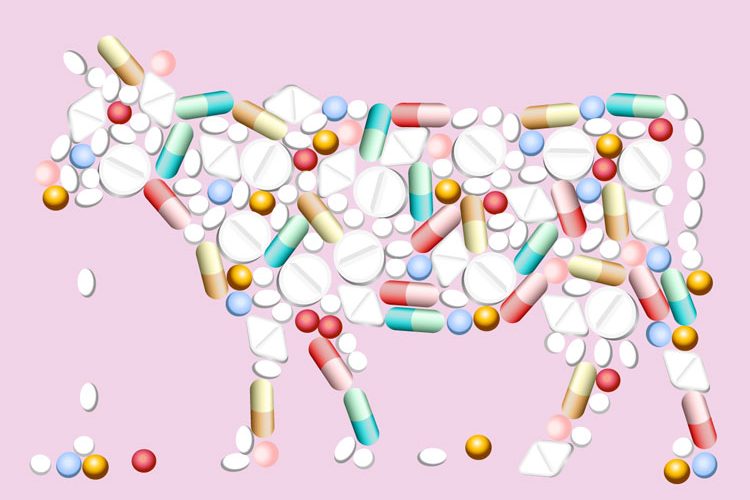Drug residues in the global food market
- Like
- Digg
- Del
- Tumblr
- VKontakte
- Buffer
- Love This
- Odnoklassniki
- Meneame
- Blogger
- Amazon
- Yahoo Mail
- Gmail
- AOL
- Newsvine
- HackerNews
- Evernote
- MySpace
- Mail.ru
- Viadeo
- Line
- Comments
- Yummly
- SMS
- Viber
- Telegram
- Subscribe
- Skype
- Facebook Messenger
- Kakao
- LiveJournal
- Yammer
- Edgar
- Fintel
- Mix
- Instapaper
- Copy Link
Posted: 18 September 2018 | Daniel Hughes | No comments yet
The potential presence of drug residue contaminants in products destined for human consumption is of increasing importance within the industry, but what are the main challenges posed by this issue? Daniel Hughes has some answers.


Drug residue contaminants in food products and what to do about them is a discussion for the global community. However, each individual country or trade bloc has its own protocols and regulations relating to the control and monitoring of residues. These different legislations are designed to protect the general public as well as the food industry interests in their individual countries and any business that wishes to sell its products within other countries or regions must meet their legislative requirements relating to drug residues. These differences in regulations have increased the need both for more dialogue on the issue and to implement effective monitoring systems.
It is clear that the industry must deal with the potential of residues from antibiotics and growth-promoting hormones entering the food chain. This will involve ensuring correct dosage per animal and also adhering to withdrawal periods set for their region. Of equal importance, however, is the issue of the stigma faced by the industry from the misuse of these antibiotics and growth-promoting hormones.
While there is a potential for misuse, a producer’s main concern should always be animal health, which
With humidity levels rising in recent years, there has been an influx in the level of mycotoxins found within feed and cereals
leads to a quality end product. Antibiotics are used to ensure the health of the animal and to reduce the potential knock-on effect of untreated diseases that could create a downturn on yield. Growth promoting hormones are used to increase this yield too, but this practice should never be carried out at the expense of a safe end product.
Residues from particular drugs in food produce can have serious implications for human health. As such, many countries have set Maximum Residue Limits (MRLs) or tolerances for these residues in food. The Maximum Residue Limit is the maximum concentration of a residue that can be present in a product from an animal or animal by-product intended for the food chain. These MRLs mean that it is required by law in the enforcing countries that any product in the food chain cannot contain residue levels that are harmful to human health above these limits.
There has been controversy over measures to tackle drug residues in foods, as there are no internationally accepted standards for many drugs. Ractopamine, in particular, has caused trade disputes, as it is permitted in food production in some countries such as the US and Canada, but the European Union, China, Taiwan and over 100 other countries have banned its use.
The real challenge for the food industry is ensuring its testing methods are effective and reliable, to assure public access to safe end products. To illustrate the diversity of these products we can look at the dairy, meat, seafood, feed and honey markets.
Dairy market
The dairy industry is under constant scrutiny and pressure to produce consistently high volumes of milk while maintaining a superior standard of quality in its dairy products. As part of the production process, various contaminants are administered to cattle in an effort to systematically treat various infectious diseases and maintain a healthy herd. A direct consequence of this is the requirement of routine monitoring and testing within farms and dairy processors to ensure that the levels of contaminants in milk are within legal regulations to not exceed Maximum Residue Limits and a complete absence of any unauthorised substance.
Testing can be conducted at several points throughout the production process. Firstly, farm-level testing can be carried out to screen milk from cows that have been separated from the herd and undergone antibiotic treatment. Secondly, the dairy processor is required to conduct testing both onsite, taking samples from tankers, and retrospectively as a method of internal surveillance, thereby ensuring the milk supplied from several farms is within global regulatory limits. Thirdly, retailers can test the processed milk end product to guarantee that it’s antibiotic-free before becoming available to consumers on supermarket shelves.
Meat market
Global meat production and consumption have increased rapidly in recent decades. Worldwide meat production has tripled over the last four decades and increased by 20 percent in just the last 10 years. Meanwhile, consumers in industrial countries are eating growing amounts of meat – nearly double the quantity of those in developing countries. However, the mass quantities of antibiotics being used on livestock to reduce the impact of disease, are contributing to antibiotic resistance in animals and humans alike. Worldwide, 80 percent of all antibiotics sold in 2009 were used on livestock and poultry – the remaining 20 per cent being used for humans.
Growth promoters, which are tested for under the National Residue Control Plan (NRCP), are hormonal and antibiotic substances that may be used for growth promotion in livestock animals, thus increasing the production of muscle meat and the reduction of fat. The type of growth promoter used is dependent on the animal species and mode of rearing: steroid growth promoters are used for beef cattle; antibiotic growth promoters, which are usually added to feedstuffs such as the coccidiostats, are used in the poultry industry; and chlortetracycline is used in the porcine industry. The rapid speed of meat production necessitates frequent testing for drug residues to prevent them from entering the food chain.
Seafood market
The global aquaculture industry has grown steadily over the past five decades, increasing at an average rate of 3.2 per cent per annum. However, this growth has come at a cost and the industry is facing many new challenges. Farmed seafood is often treated with medicated feeds that contain antibiotics such as leucomalachite green and nitrofurans, for example, to prevent the spread of disease; they are also exposed to other harmful residues from chemicals used to treat algae etc, within the ‘pens’ in which they’re kept.
The FAO (2012) reported that 38 percent of fish produced globally is exported, highlighting the imbalances in regional supply and the changing tastes of the global consumer. This increased level of exporting and importing shows the importance of drug residue screening within the global aquaculture industry.
Feed market
The global animal feed processing market is estimated at US$21.61 billion in 2018 and projected to reach US$26.62 billion by 2023. The market is driven by factors such as the rising awareness of feed nutrition and health, technological advancements in the equipment industry and an increase in the demand for feed around the world. Medicated feeds are often used to help prevent disease within livestock, and there are MRLs for these. This has created the need for testing, because high levels of residues can have an effect on livestock health and can transfer through to meat products for human consumption. With humidity levels rising in recent years, there has been an influx in the level of mycotoxins found within feed and cereals. These toxins are fungal and can affect both livestock and human health; for example, mycotoxicosis – a disease that can affect the respiratory system. The main cause of mycotoxins in stored grains is when the grain is damp or cracked and kept in unsuitable storage conditions. These factors have made it necessary for feed and cereals to be tested for both drug residues and mycotoxins to ensure that they do not end up in the food chain.
Honey market
The global honey market is growing at a rapid pace with global consumption of honey forecast to reach 2.5 million tonnes by 2022. This growth is driven by consumers’ demand for natural and healthy alternatives to artificial sweeteners over cane sugar. There is also a growing awareness of the health and healing benefits of honey, which is driving the demand for the use of honey for medicinal use.
Manuka honey sales continue to grow, thanks to its antibacterial and anti-inflammatory properties.


The rapid rise in demand for honey far outweighs the amount that can be naturally produced globally, causing producers to dilute with syrups
However, the rapid rise in demand for honey far outweighs the amount that can be naturally produced globally, due to a decline in the number of bees. This has influenced the quality of the honey we are seeing on the market, as some producers choose to dilute natural honey with high-fructose corn syrups in order to meet the demand. There is a requirement for keepers to treat bee colonies with antibiotics to prevent CCD (colony collapse disorder) and infestations such as varroa mites, and there is a chance that these harmful drug residues can be transferred through to the end product – ie, ‘natural’ honey. The use of antibiotic drugs in apiculture is globally restricted and there are no MRLs set for antibiotics in honey, as it’s a natural product and thus needs to be antibiotic-free. This has created a need for testing; both for drug residues and to determine the overall quality of the honey being produced.
Detection
Due to the requirement to use a variety of drug treatments in the food industry – and also the potential economic benefits to be gained from the use of growth promoters – there will continue to be drug use in animal production. However, as analytical methods of detection become more sensitive, producers are given further options for testing.
The surveillance for the potential presence of residues of veterinary substances is regulated by the EU Directive 86/469/EEC. This directive outlines the guidelines for sampling and testing within a residue monitoring programme.
The requirement to meet these standards and the MRLs and detection levels outlined in the legislation has created a need for analytical methods to become more sensitive, to ensure precise analysis. This lowering of MRLs means technology sensitive enough to detect very low concentrations in a sample is now required.
One such screening method that is commonly used is the enzyme-linked immunosorbent assay (ELISA) method, which works well for testing and provides accurate results. Using similar methodology, our lab has developed another type of analysis using biochip array technology (BAT) to perform simultaneous quantitative detection of multiple analytes from a single sample. The Evidence Investigator can be used to detect residues, even in very small concentrations, across multiple matrix types within the food industry.
About the author
Daniel Hughes, MIFST, has been working as a technical support scientist with Randox Food Diagnostics since 2016, and is currently a member of the Institute of Food Science and Technology.
Issue
Related topics
Contaminants, Environment, Food Safety, Health & Nutrition, Quality analysis & quality control (QA/QC), Regulation & Legislation, Supply chain
Related organisations
Food and Agriculture Organization of the United Nations (FAO)









